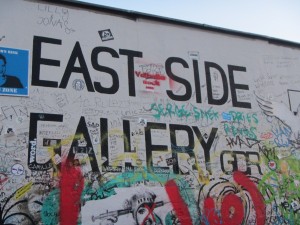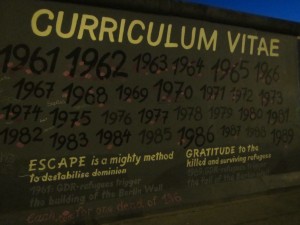Inspired by my earlier post about tattoos and life narratives, I have been on an ‘artistic high’. So, last night I was rummaging through my old photos of my trip Europe trip this past summer. I came across some pictures I took of the East Side Gallery in Berlin and all of the incredible artwork that is shared on a piece living history. If you are not familiar with the history of the Berlin Wall (click here) for some context. Each section of the wall has a piece of art to commemorate and remember the hardships of Germany during its separation. Many of which are in the form of graffiti or paintings, they are all beautiful to look at. As I continued to delve into my album I began to notice certain trends and patterns within the artworks. They were all connected by paying tribute to Germany and more than that its people.

We have been exploring the idea of identity, remembering and trauma in the Art Studies class that I am taking at UBC. By looking through my photos of the East Side Gallery we can see how these artists in a way are preserving their German identity and marking history through their art work. The significance of having these works displayed publicly and openly on one of the most infamous pieces of architecture shows the process of healing through art.
Here are some of the photos I took:
We can see within these particular artworks as a means to illustrate and convey identity and trauma during the precarious times of Germany’s division. During this time, there were many individuals trying cross the border, especially those living in Soviet controlled East Berlin wanting to escape to West Berlin. Many people were killed attempting to cross, which inspired some of the artwork on what is left of the wall.
From the pictures that are displayed and the patterns I noticed within the artwork. Either through the form of quotes or illustrations of people, the artists convey the voices of those who perished trying to break away from the separation. We can see in the second photograph a flood of faces that are unidentifiable, yet… are meant to be represented for the victims affected by the wall. In photos 1, 3, & 4 the use of text can be seen as a way to narrate the thoughts and spirits of those who suffered through this tragic time. #1 pays tribute to those who died trying to escape but remain unknown and also those affected but remain voiceless, this artist is giving voice and identity to those individuals through his artwork. #2 shares the thoughts of why many artists chose to paint on this infamous wall as a means of healing the traumatic past. Finally, #3 has its text in both German and English, representing two identities coming together as one to show how individuals can defeat these hardships. These of course, are my analyses of the artworks, they are all open to interpretation.
The East Side Gallery is not only a wall full of artworks, but they are a collection of narratives that convey the life during and after WWII and the times of the Berlin Wall. Many artists used this form of art to convey a message, and to share the experience of living during those tragic times. Moreover, how they choose to publicly convey these messages through art and have them open to interpretation rather than published in official text. There is something very empowering with how these individuals choose to confront the tragedy by painting directly on the structure that confined them, and sharing their healing process for others to see.
This collection of art is not only to help narrate the times of the Berlin Wall but also to give identity to the fallen. Furthermore, the paintings on this wall is a way to remember, remember trauma and healing for both the individuals and the nation. By having this wall and artwork on display and freely open to the public sends a powerful message of how a nation together has overcome all battles.
If anyone is truly interested in looking more deeply into the artworks you can check out this link here: http://www.eastsidegallery-berlin.de/ or simply Google images “East Side Gallery”.





Hi Lynsee,
This post was really interesting for me as a history buff, because I find WWII and post WWII a very interesting. Something you didn’t touch on, but is also related to the berlin wall is the commodification of the berlin wall itself. I remember watching a documentary on how vendors were buying pieces of art hat were created along the wall and then smashing them up so tourists could buy a “piece” of the berlin wall. Just a quick google search brought me to this ebay page where people are selling the wall http://www.ebay.com/bhp/berlin-wall.
I think this is very interesting because while yes people make these beautiful art pieces along the wall highlighting a divided and crushed nation people are also destroying it to make a profit for westerns who want to hold history in their hands.
Hi Lynsee,
It was so interesting to view pictures of the Berlin Wall from your trip. The Berlin Wall has so many historic significances as well as being an iconic structure in the world that the art and writings on the wall are very effective in demonstrating a poignant moment in history. I thought the photo #2 was very haunting as it showed the thousands of faces wanting to break free from the barriers of the wall. I think visuals can easily show the emotional aspect of any life narrative. Drawn on these faces are the pain and suffering experienced during the war which is difficult to imagine in a literary life narrative.
Also, I agree with your point of people healing by these drawings and writings on the wall. Instead of constantly being a historic image of restriction, it has become an art piece where people can freely express themselves.
Lynsee,
What a provocative post! These images are important examples of how history carries on, in my view, in that more modern graffiti provides insight onto the thoughts of others before them. In a sense, they create a conversation between different scholars. Even if the grammar and language is lapsing in some or all of the graffiti posts, messages against trauma and supporting the rebuilding of identity of Germany is scholarly. Your post caused me to question the symbolism of the wall as you mentioned. While I agree that the wall has become a symbol for the fallen and the past, I think it is even more so symbolic of the present. Germany as a nation has had many hardships throughout both World Wars and the Cold War, and the fact that the wall has been broken down and written on is empowering for those who live in Germany now. It is their families who survived the brutality of the Wall and a sense of identity and connection to the past can be found in the contemporary graffiti on the much older wall.